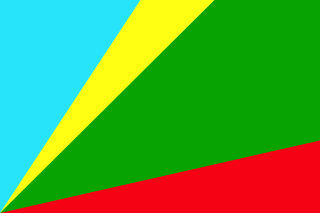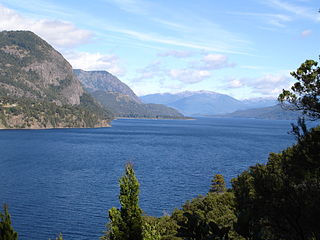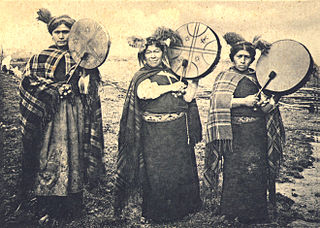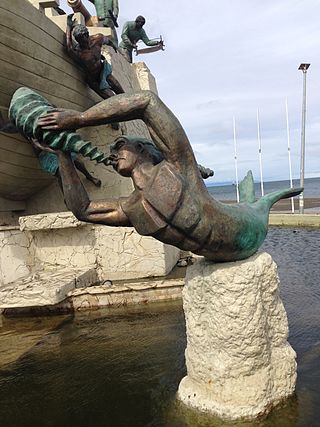
The Huilliche, Huiliche or Huilliche-Mapuche are the southern partiality of the Mapuche macroethnic group in Chile and Argentina. Located in the Zona Sur, they inhabit both Futahuillimapu and, as the Cunco or Veliche subgroup, the northern half of Chiloé Island. The Huilliche are the principal indigenous people of those regions. According to Ricardo E. Latcham the term Huilliche started to be used in Spanish after the second founding of Valdivia in 1645, adopting the usage of the Mapuches of Araucanía for the southern Mapuche tribes. Huilliche means 'southerners' A genetic study showed significant affinities between Huilliches and indigenous peoples east of the Andes, which suggests but does not prove a partial origin in present-day Argentina.

The Mapuche are a group of indigenous inhabitants of south-central Chile and southwestern Argentina, including parts of Patagonia. The collective term refers to a wide-ranging ethnicity composed of various groups who share a common social, religious, and economic structure, as well as a common linguistic heritage as Mapudungun speakers. Their homelands once extended from Choapa Valley to the Chiloé Archipelago and later spread eastward to Puelmapu, a land comprising part of the Argentine pampa and Patagonia. Today the collective group makes up over 80% of the indigenous peoples in Chile and about 9% of the total Chilean population. The Mapuche are concentrated in the Araucanía region. Many have migrated from rural areas to the cities of Santiago and Buenos Aires for economic opportunities, more than 92% of the Mapuches are from Chile.

San Carlos de Bariloche, usually known as Bariloche, is a city in the province of Río Negro, Argentina, situated in the foothills of the Andes on the southern shores of Nahuel Huapi Lake. It is located within the Nahuel Huapi National Park. After development of extensive public works and Alpine-styled architecture, the city emerged in the 1930s and 1940s as a major tourism centre with skiing, trekking and mountaineering facilities. In addition, it has numerous restaurants, cafés, and chocolate shops. The city had a permanent population of 108,205 according to the 2010 census. According to the latest statistics from 2015, the population is around 122,700, and a projection for 2020 estimates 135,704.

In the traditional Chilote mythology of Chiloé, Chile, the Trauco is a humanoid creature of small stature—similar to a dwarf or goblin—who lives deep in the forest. It has an ugly face and legs without feet.

Lácar Lake is a lake of glacial origin in Neuquén Province, Argentina. It is enclosed in the Andes mountain range, at 630 m above mean sea level. The area around the lake is mostly uninhabited, except for the city of San Martín de los Andes on its northeastern coast. The lake has a surface area of 55 km2 (21 sq mi) and a mean depth of 167 m, with a maximum of 277 m. Its catchment basin comprises 1,048 km2 (405 sq mi). Like many Andean Argentine lakes, it drains across Chile and into the Pacific Ocean, in this case via the Huahum River that flows through Huahum Pass in the Andes. As the northernmost lake on the eastern side of Andes that drains to the Pacific the lake and its catchment basin were claimed by Chile until 1902 based on an interpretation of the Boundary treaty of 1881 between Chile and Argentina. The lake, along with the smaller lake nearby, Lolog, has some sacred significance for the Mapuche people, as it features in their oral tradition as part of a creation myth. Large sections of the lake's shores are made of cliffs.

The religion of the indigenous Mapuche people of south-central Chile and southwestern Argentina is an extensive and ancient belief system. Legends and myths are common to the various groups that make up the Mapuche people. These myths tell of the creation of the world and the various deities and spirits that reside in it.
The Chilote mythology or Chilota mythology is formed by the myths, legends and beliefs of the people who live in the Chiloé Archipelago, in the south of Chile. This mythology reflects the importance of the sea in the life of Chilotes.
Ten Ten-Vilu or Trentren-Vilu is the Mapuche god of earth and fertility ; he has a generous spirit and is the protector of all life on Earth, and the flora and fauna and according to some Mapuche myths. This snake was a central figure in the origin of the Chiloean Archipelago. In Mapuche mythology, Ten Ten-Vilu is son of Antü.

Coi Coi-Vilu or Caicai-Vilu/Cai Cai Vilu is the Mapuche god of water and, according to Mapuche myths, supreme ruler of the sea and of all sea-dwellers. This snake was a central figure in the origin of the Chiloean Archipelago. In Mapuche mythology, Coi Coi-Vilu is son of Peripillan.
The Piuchén is a creature from the Mapuche mythology and Chilote mythology pertaining to southern Chile, a much feared shapeshifting creature that can instantly change into animal form. According to legend, the Piuchén takes the hearts of its victims without leaving a mark on the body.
Chilean mythology includes the mythology, beliefs and folklore of the Chilean people.

The Chiloé Archipelago is a group of islands lying off the coast of Chile, in the Los Lagos Region. It is separated from mainland Chile by the Chacao Channel in the north, the Sea of Chiloé in the east and the Gulf of Corcovado in the southeast. All islands except the Desertores Islands form Chiloé Province. The main island is Chiloé Island. Of roughly rectangular shape, the southwestern half of this island is a wilderness of contiguous forests, wetlands and, in some places, mountains. The landscape of the northeastern sectors of Chiloé Island and the islands to the east is dominated by rolling hills, with a mosaic of pastures, forests and cultivated fields.

The Chono, or Guaiteco were a nomadic indigenous people or group of peoples of the archipelagos of Chiloé, Guaitecas and Chonos.
Cuncos, Juncos or Cunches is a poorly known subgroup of Huilliche people native to coastal areas of southern Chile and the nearby inland. Mostly a historic term, Cuncos are chiefly known for their long-running conflict with the Spanish during the colonial era of Chilean history.

The dalca or piragua is a type of canoe employed by the Chonos, a nomadic indigenous people of southern Chile, and Huilliche people living in Chiloé archipelago. It was a light boat and ideal for navigating local waterways, including between islands of the Chiloé Archipelago, through the Chacao Channel to mainland Chile, and along the coast of the Gulf of Penas. Spanish chronicles called it best-suited for those waters, far superior to ships of the conquistadores.
As an archaeological culture, the Mapuche people of southern Chile and Argentina have a long history which dates back to 600–500 BC. The Mapuche society underwent great transformations after Spanish contact in the mid–16th century. These changes included the adoption of Old World crops and animals and the onset of a rich Spanish–Mapuche trade in La Frontera and Valdivia. Despite these contacts Mapuche were never completely subjugated by the Spanish Empire. Between the 18th and 19th century Mapuche culture and people spread eastwards into the Pampas and the Patagonian plains. This vast new territory allowed Mapuche groups to control a substantial part of the salt and cattle trade in the Southern Cone.
The Parliament of Las Canoas was a diplomatic meeting between Mapuche-Huilliches and Spanish authorities in 1793 held at the confluence of Rahue River and Damas River near what is today the city of Osorno. The parliament was summoned by the Royal Governor of Chile Ambrosio O'Higgins after the Spanish had suppressed an uprising by the Mapuche-Huilliches of Ranco and Río Bueno in 1792. The parliament is historically relevant since the treaty signed at the end of the meeting allowed the Spanish to reestablish the city of Osorno and secure the transit rights between Valdivia and the Spanish mainland settlements near Chiloé Archipelago. The indigenous signatories recognized the king of Spain as their sovereign but they kept considerable autonomy in the lands they did not cede. The treaty is unique in that it was the first time Mapuches formally ceded territory to the Spanish.

Millalobo is an important being in Chilote mythology. He is the most powerful being of the sea after Caicai and was chosen by Caicai to be his representative and govern all that resided in the sea.

Agriculture in Chile has a long history dating back to the Pre-Hispanic period. Indigenous peoples practised varying types of agriculture, from the oases of the Atacama Desert to as far south as the Guaitecas Archipelago. Potato was the staple food in the populous Mapuche lands. Llama and chilihueque herding was practised by various indigenous groups.
[Chile] is rich in pastures and cultivated fields, in which all kind of animals and plants can be breed or grown, there is plenty of very beautiful wood for making houses, and plenty of firewood, and rich gold mines, and all land is full of them...

Nahuel and the Magic Book is a 2020 Chilean-Brazilian animated fantasy-adventure coming-of-age film produced by Carburadores, co-produced by Chilean Punkrobot Studios and Brazilian Levante Films and directed by Germán Acuña Delgadillo. This is the first animated feature that was made in Chile in collaboration with Brazil and this is the first Chilean-Brazilian 2D animated film that entered the Annecy International Animation Film Festival in Annecy, France on June 15, 2020 and in Chile on January 20, 2022.













